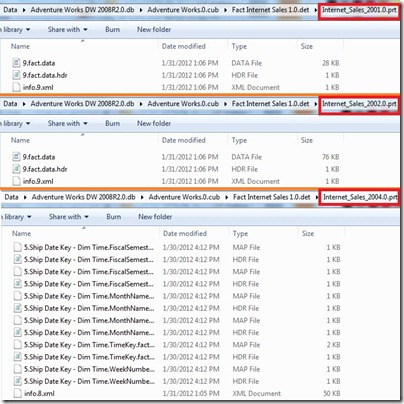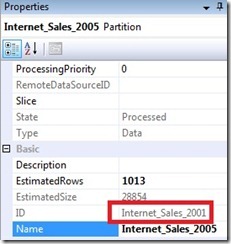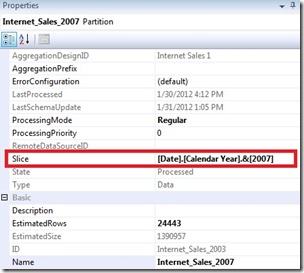Set the Slice on your SSAS Cube Partitions now!
Reposted from Jason Thomas blog with the author's permission.
I am pretty sure that most of you would have heard or read about this at least once in your SSAS career, but how many of you actually do set slices for your partitions? Well, I am also guilty of the charge and seldom did set slices till a recent issue.
Situation : Duh, that’s strange!
It’s a sunny day in Charlotte and I was just playing around with SQL Server Profiler for learning some performance tuning stuff. I executed this simple MDX query on the sample Adventure Works DB for some purpose which is beyond the scope of this post -
select {[Measures].[Internet Sales Amount]} on 0,
{[Ship Date].[Calendar].[Month].&[2008]&[4]} on 1
from [Adventure Works]
Now while I was going through the Profiler trace, I noticed something strange – three partitions (2005, 2006 and 2008) were being read while I expected just one partition (for 2008) to be read as my query just had April 2008 on the rows.

Now, for people who are not familiar with Adventure Works cube, there are four partitions for the Internet Sales measure group, one for each year from 2005 to 2008 as shown below -
I decided to take a detour from my actual purpose to investigate this issue.
Debugging : Need to dig up that grave!
I was aware that SSAS partitions generate automatic data slicers for each partition and these information are present in the info.*.xml file of the partition data file (you can find them usually at C:\Program Files\Microsoft SQL Server\MSAS10_50.MSSQLSERVER\OLAP\Data folder followed by the cube, measure group and partition name if you haven’t changed the default settings. Note that I am using SQL Server 2008 R2). I decided to have a look at these three partition data files.
As seen above, there was clearly a difference between the partitions of 2005 / 2006 and 2008 (which are having the names Internet_Sales_2001.0.prt / Internet_Sales_2002.0.prt and Internet_Sales_2004.0.prt. These names are the partition IDs and can be seen in the ID property of the partitions)
It seemed like the auto-slices were not getting created for the 2005 and 2006 partition while it was being done for the 2008 partition. This was further confirmed on opening and inspecting the info.*.xml file with notepad.
Knee-jerk Solution : Or is it?
I went into research mode on Google and soon came up with a property in the msmdsrv.ini file which limits the creation of auto-slicers based on the number of rows in the partition – the IndexBuildThreshold property.
By default, the value is 4096 rows and both the partitions for 2005 and 2006 had less than 4000 rows. This explained why the auto-slicers were not getting created and I modified it to 1000. Now on reprocessing the measure group, I was able to see that the auto-slicers were generated in the partition data files and only the correct partition was being read in the profiler trace.
Actual Solution : The real deal!
I decided to gloat over my findings to my friend and colleague, Javier Guillen (blog | twitter) who was sitting in the next room. When I described the problem statement to him, the very first question he asked me was whether I had set the partition slices, and I was like – sheesh, I missed on that cardinal rule, as usual. I was under the impression that as long as your partition is for a single data member (as in this case – a single year), it should work. But later I found out that partitions for which autoslices are not generated will be scanned anyway, unless the partition slices are explicitly defined. I went back and set the slices for each partition correctly to their respective years and also reverted the IndexBuildThreshold property to the original value of 4096.
Once this was done, I processed my measure group and found out that only the correct partitions were being read from the trace files.
Reading Materials
I took some time to read and learn more about partition slices, thought you would be interested in it too if you made it this far.
1) Get most out of partition slices - Mosha Pasumansky
2) SSAS Partition Slicing - Eric Jacobsen
3) Partition Slice Impact on Query Performance - Jesse Orosz
 |
Jason has been working with Microsoft BI tools since he joined the IT industry in 2006. Since then he has worked across SSAS, SSRS and SSIS for a large number of clients. He is currently working for Mariner and is based out of Charlotte, NC. His personal blog can be found at http://road-blogs.blogspot.com |
Tags: partition, management, performance






